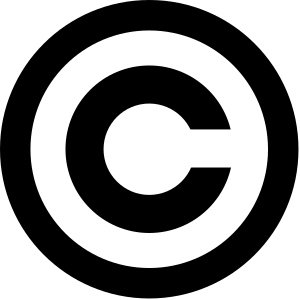Copyright facts for kids
A copyright is a law that gives the person who created something, like a book, a song, a picture, or a movie, the right to decide how others can use it. Think of it as a special permission slip for your creative work! Copyright laws help creators earn money from their ideas and hard work. Because of copyright, no one can copy or use a creative work without the owner's permission.
If someone copies or changes a copyrighted work without permission, the owner can take legal action. This usually involves civil law, where the owner might ask for money for the damage caused. In very serious cases, copying a copyrighted work without permission could lead to fines or even prison.
Contents
Who Owns Copyright?
In most countries, the person who creates a work automatically owns the copyright. You don't usually need to do anything special to get it.
Some countries let you register your copyright, but it's not always required. However, many creators choose to register their work, especially if they plan to sell it. Registering helps to prove that you are the true owner of the copyright.
Sometimes, if you create something for someone else, like for your employer, the copyright might belong to them. For example, if a person working for a company like Microsoft creates a new computer program during work hours, Microsoft would usually own the copyright for that program.
How Long Does Copyright Last?
Copyright laws usually protect creators for a long time, even after they pass away. In many places, copyright lasts for 50 years after the creator's death. Some countries have extended this period to 70 years.
When the copyright protection ends, the work enters the public domain. This means it's free for everyone to use! No one owns the copyright anymore, so people can copy, use, and change the work without asking for permission or paying anyone.
What is Fair Use?
Copyright doesn't stop all copying. There's a special exception called fair use. This rule allows people to copy a small part of a copyrighted work for certain reasons.
Fair use is often allowed for things like:
- Reviews: When a newspaper writer quotes a few sentences from a book to write a review.
- Research: When a university professor uses parts of a book in a research report.
- Education: Teachers can copy material onto a blackboard or an interactive whiteboard for lessons. Students can also copy that material into their notebooks.
- School Projects: Using copyrighted pictures in school work, as long as you say where you got them (like "Image from Google").
However, making many copies for business reasons is usually not fair use.
Making Copies for People with Disabilities
It is legal in many countries, including the United Kingdom and the United States, to make special versions of copyrighted works for people with disabilities. For example, you can create a large print or braille version of a book for someone who is blind or visually impaired, without needing permission from the copyright owner. This helps make books and other works more accessible to everyone.
Copyright Around the World
Different countries have slightly different copyright laws. The main differences are usually about:
- Whether government works are copyrighted.
- How long copyright lasts after the creator dies.
- What counts as fair use.
Because of these differences, a work might be copyrighted in one country but free to use in another.
Why Copyright Matters
Creativity and New Ideas
Some people believe copyright laws help people create more new works. If creators can earn money from their ideas, they'll want to make even more! This encourages new books, songs, and movies.
But others think copyright laws can sometimes make it harder to be creative. They argue that if people could freely reuse existing works, it might lead to even more new ideas.
Publishers and Creators
If a creator wants to sell their work, they often work with a publisher. The publisher helps sell the work and takes a part of the money. But publishers have many things to sell, and they might not always want to sell a new creator's work. It can be tough for new creators to find a publisher.
Some people feel that copyright laws help big publishers stay in control of the market. This can make it harder for smaller creators to get their work out there.
Open Content
To solve some of these problems, many creators have started using open content. With open content, creators give everyone permission to copy, change, and share their works. They just ask that people follow a few simple rules. These rules are explained in an open content license.
Some common open content rules are:
- If you change the work, or make something new based on it, you must give credit to the original creator. You need to say who made it first.
- If you share your changed work, you must let others use it under the same free license.
- Some licenses say you cannot sell the work or use it to make money.
Sometimes, open content is also called Copyleft.
Related Pages
Images for kids
-
The Statute of Anne was an important law about copyright that started in 1710.
See also
 In Spanish: Copyright para niños
In Spanish: Copyright para niños







